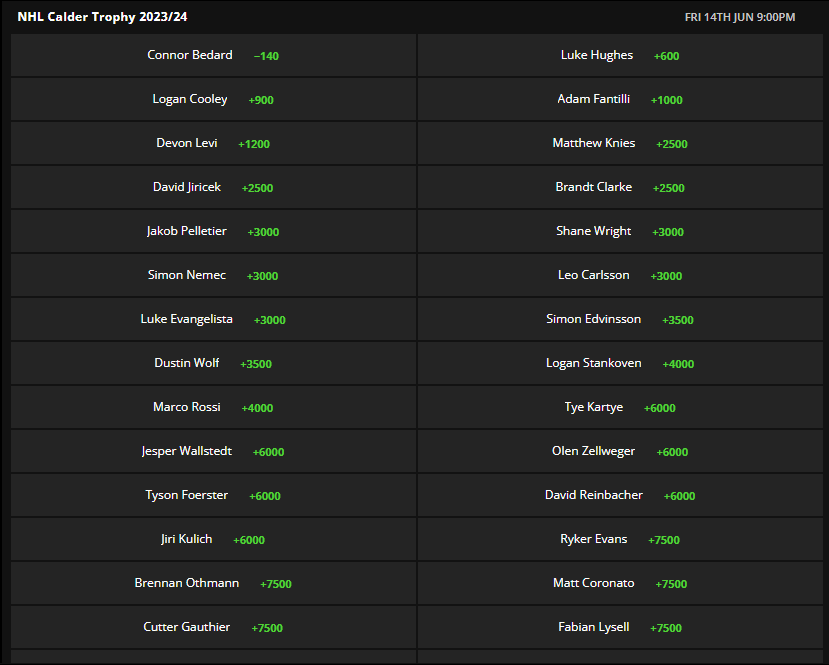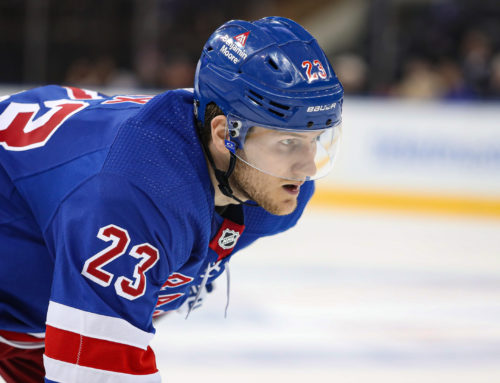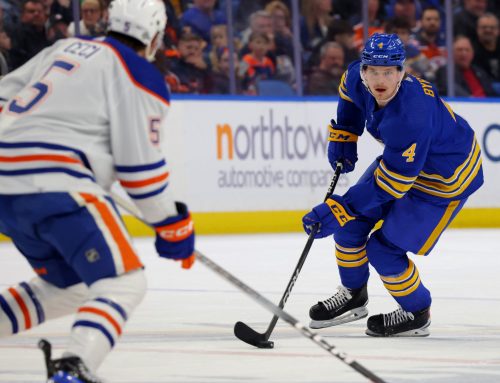The 2023-24 Dobber Hockey Fantasy Guide is available in the Dobber Shop! It has projections, a draft list, depth charts, updates on prospects, fantasy-specific articles from our writers, and a whole lot more. As it's online, it is updated for new information, and that is helpful during training camp. Support what we do and grab a copy today!
*
Last week, I was perusing some preseason betting odds for everything from team point totals to player point totals, to awards and statistical achievements, and a few more. Among these betting odds was the Calder Trophy and, as expected, Connor Bedard is a massive, massive favourite to win. But it led me to another question: who else should we consider? I asked my Twitter followers to look at the following picture (from DraftKings) and provide me with a guy they'd bet on to win Rookie of the Year other than Bedard at the odds that were offered:

For anyone needing a betting refresher, Bedard at (-140) means he's priced as if there's a 58% chance he'll win. The next-closest player is Devils prospect defenceman Luke Hughes at (+600), which means he's a 6-1 underdog, and about 14% to win. After that it's Logan Cooley at (+900), or 9-1 and an even 10%. To compare to last year, I found an article from The Action Network that had Matty Beniers at (+500) – just under 17% – and he was the favourite. Bedard is in another stratosphere.
I got a lot of responses to my Twitter prompt, so I wondered what has to happen for someone other than Bedard to win the Calder Trophy? If that were to happen, they'd likely be a tremendous fantasy asset, so this is a way to get two birds stoned at once.
Let's start with the previous winners.
There have been 18 Calder winners since the 2004 lockout. Of those 18 players, there are 13 forwards (72%), four defenceman (22%), and just one goalie (Steve Mason, 2008-09). However, two of the last four winners have been blue liners, and three of the last nine. The game has changed for rearguards, but the data revolution over the last 10-or-so years has surely played a factor; evaluation tools have improved and it's easier to measure impact from the back end than ever before.
Of the 18 winners, only two were over 21 years old, and both Kirill Kaprizov and Artemi Panarin were KHL imports. The simplest explanation would be that if a player excelled at 19 or 20 years old, they're in the NHL before they're 22 or 23 years old.
The reason it's hard for goalies to win Calder honours is first-year goalies are almost never thrust into a starting role: there have only been six rookie goalies with at least 40 starts in any of the last 10 separate 82-game seasons. Just one of those six goalies ended with a 30-win season (Matt Murray, 32, 2016-17). The most recent decade had one rookie goalie with 30 wins, something nine veteran goalies did in 2022-23.
Alright, with all that out of the way, what has to happen for someone other than Bedard to be Rookie of the Year? Let's assume Bedard has a really good rookie season for almost any player but ends up with 29 goals and 57 points. Besides "get lucky", "play well", and "a (few) key player(s) sustain season-ending injuries", how does one of the long shots win the Calder? I'm going to use some of the popular responses I got on Twitter to guide us. As usual, data from Frozen Tools and Natural Stat Trick unless otherwise indicated.
Luke Hughes (NJD-D)
Impediment: New Jersey has a top PP unit that gets the lion's share of ice time, and Dougie Hamilton runs that unit. It was a mid-pack power play by goals per minute, but also New Jersey's best power play in five years. The last three Calder winners from the blue line – Aaron Ekblad, Cale Makar, Moritz Seider – averaged 20 power-play points/82 games for their rookie season. Hughes won't get there if he's stuck on PP2 all season. Since 2007, the only defenceman to put up 30 even-strength points in his age-20 season is Ivan Provorov (31, 2017-18). Secondary PP minutes would probably leave Hughes shy of 40 points.
Path To The Calder: The New Jersey power play would need to falter through the first month of the season as Hughes shows his tremendous upside. If he can supplant Hamilton sometime in the first 20 games, pushing Hughes over 20 minutes each night by mid-to-late-November in mostly offensive roles, it would put 50-plus points and a Calder Trophy on the table.
Logan Cooley (ARI-C)
Impediment: For the first time in several years, Arizona is trying to ice a competitive team. If this were August of 2022, Cooley may have a direct path to top-line minutes out of training camp. As it stands now, Barrett Hayton has the inside track to skating with Clayton Keller at all offensive strengths, Nick Bjugstad was brought back, and Alex Kerfoot – who played a lot of centre until his last couple seasons in Toronto – was signed. The team has enough offence where Cooley might still get, say, Jason Zucker or Mattias Maccelli on his line, but it's a big gap in player quality and ice time.
Path To The Calder: The Hockey Prospecting model was high on Cooley, and his Draft+1 year only improved his stock:
[COOLEY]
A push for a Calder Trophy would probably have more to do with his teammates than Cooley himself. In the last two seasons for the Coyotes, only Keller has reached the 20 PPP mark, and topped out at 21. Schmaltz paced for 16 in 82 games last season. Even if Cooley gets top PPTOI for two-thirds of the year, he may not put up more than a dozen PPPs. Not only does Cooley need prime offensive minutes, but the team needs to be better in those minutes. If that happens, the 19-year-old might have a big post-Christmas effort (like Hayton did), and a push for the Calder Trophy.
Devon Levi (BUF-G)
Impediment: Coaches.
No, honestly. Coaches are very reticent to give rookie goalies a meaningful workload; in the last 10 full NHL seasons, no goalie has more than 52 starts (Alex Nedeljkovic in 2021-22), and only two have reached 50 starts (add Mike Condon in 2015-16). One of the respondents on Twitter made a good point:
Had Stuart Skinner made 57 starts and won 35 games, maybe this is a different story, but he didn't, so it's not.
Path To The Calder: Improve on last year's small sample behind an ascending Buffalo defence for a full season as the Sabres get back to the playoffs. As I've often noted this offseason, Buffalo barely missed the postseason and an extra key save from a goalie at any point in the year would have gotten them in. If Levi has 34 wins and a .915 save percentage, he will be among the non-Bedard contenders.
Matthew Knies (TOR-LW)
Impediment: For years, Toronto has had Some Guys in their bottom-6 that were never a real threat for top-6 minutes. Wayne Simmonds, Jason Spezza, David Kampf (and he's still not a threat), Zach Aston-Reese, and the list goes on. They didn't seem too keen on Ilya Mikheyev or Pierre Engvall, either. Now, though, they replaced Michael Bunting with Tyler Bertuzzi, Nick Robertson is (theoretically) healthy, they signed Max Domi, and Calle Jarnkrok has earned some favour over the last couple seasons. That, combined with a loaded top PP unit, could limit Knies's prime offensive minutes.
Path To The Calder: At times over the years, William Nylander has been given the heave-ho from the top PP unit. That included the 2023 playoffs when Ryan O'Reilly was given top billing. It probably won't happen to start the year, but if he continues showing as well as he did in his brief tenure last season, Knies could get there by Christmas. Even strength minutes next to Tavares/Nylander and top PP minutes for half the season could get Knies a Calder Trophy.
***
For more the larger group of rookies and prospects, from people who know more about them than I do, our Dobber Prospects Report is available for purchase in the Dobber Shop!
***
Brandt Clarke (LAK-D)
Impediment: Clarke was one of the most popular replies and, listen, I get it. Clarke looks like a special player and Sean Durzi moving on means there is a PP role for Clarke. However, Drew Doughty, Vladislav Gavrikov, and Mikey Anderson are all ahead of him at even strength. Expecting more than 18.5 minutes a night from Clarke – 16-ish at evens, 2-ish on the PP – is expecting too much. Keep in mind that Durzi paced for 43 points (including 18 PPPs) last season and that was with nearly 20 minutes a night.
Path To The Calder: This isn't quite the Luke Hughes situation. In Los Angeles, they ran a 60/40 split between their PP units, where New Jersey was closer to 75/25. He might only play 18-19 minutes a night, at least for the first month or two, but his PP role alone could net him 15 points. With the team adding Pierre-Luc Dubois, and getting full, healthy seasons from Quinton Byfield and Arthur Kaliyev, the Kings may be a top-10 offence at even strength. It would help give Clarke a Quinn Hughes-esque rookie year, and a push for the Calder.
Dustin Wolf (CGY-G)
Impediment: As Clarke is different from Hughes, Wolf is different from Levi. While the Buffalo goalie has no proven veteran ahead of him, Wolf has Jacob Markstrom to contend with. Markstrom had a pedestrian 2022-23 season, but he's probably a mid-tier starter akin to John Gibson or Tristan Jarry when they're healthy. If Markstrom starts strong out of the gate, Wolf just won't get the starts, and Markstrom will get some leash to start the year.
Path To The Calder: All that said, Calgary won't have patience for a bad start from their veteran goalies. If they struggle out of the gate, Wolf might be the starter by Game 10, and that could vault him right to the top of the Calder conversation. This isn't really about Wolf. He could be excellent but if Markstrom has a bounce-back season, there's not much the rookie can do about it. He needs the guys ahead of him to falter again, to take over the top gig very early in the season, and then to thrive.
Jakob Pelletier (CGY-LW)
Impediment: Even with Tyler Toffoli going to New Jersey, there is still Jonathan Huberdeau on the left side to contend with. Handedness is a problem as Calgary has *a lot* of left-handed shots: Huberdeau, Yegor Sharangovich, Dillon Dubé, Andrew Mangiapane, Blake Coleman, and Pelletier are all left-handed wingers. Some can play the right side, but they also have a couple left-handed centres in Nazem Kadri and Mikael Backlund. Handedness can be over-blown, but Calgary might only have 3-4 right-handed shots among their forwards, and that gives Pelletier a lot of competition.
Path To The Calder: The key to that competition is that, outside of Huberdeau, there isn't high-end competition. This isn't a prospect centre in Pittsburgh staring down Sidney Crosby and Evgeni Malkin. Coleman and Dubé should be on the third line, Sharangovic has to prove himself, and that leaves Pelletier with a very realistic path to second-line minutes with Kadri out of the gate. There is also a spot on the top PP unit with Toffoli gone and no heir apparent. It could be Coronato, or Mangiapane, but it could also be Pelletier.
Luke Evangelista (NSH-RW)
Impediment: Nashville just won't be very good. Getting full, healthy seasons from Filip Forsberg and Roman Josi will help, but this team was 27th by both EV and PP goals per minute last year. Matt Duchene, Ryan Johansen, Nino Niederreiter, and Mattias Ekholm are all gone, replaced by Ryan O'Reilly, Tyson Barrie, and some prospects/depth options. A 20% team-wide improvement in goal scoring only gets them to the middle of the league, so there is a long way to go before they can sustain a handful of great fantasy seasons like 2021-22.
Path To The Calder: There isn't much competition for a top-line right wing spot but that's because of the exodus of talent and a lack of proven prospects. It was a good 24-game debut for Evangelista, posting 15 points and driving the play well. If he builds on that, he could conceivably earn top line/top PP minutes for much of the season. It would give him enough minutes to have a very productive season in an otherwise difficult situation.
Logan Stankoven (DAL-C)
Impediment: The double-edged sword of a prospect playing for a great team is there are great players blocking minutes. For example, Anton Lundell played much less per game in his rookie season than Trevor Zegras. We don't need to look further than Wyatt Johnston getting 15:29 a night in Dallas just last year despite a fantastic rookie season. Stankoven could be on the team, skating on a line with Duchene, and not average 16 minutes a night. He is also miles away from getting to the heavily used top PP unit.
Path To The Calder: Johnston just had a rookie season where he was on the ice for more goals per 60 minutes at even strength than Malkin in Pittsburgh, Sam Reinhart in Florida, and Kirill Kaprizov in Minnesota, drove the play well, played all 82 games, and shot 15%. All that happened, and he put up 41 points. It really seems as if the only realistic path to the Calder for Stankoven is a handful of lengthy, key injuries to guys like Roope Hintz, Joe Pavelski, and Jamie Benn.
I think Stankoven is a very good prospect that will have a very good NHL career. A lot will have to go wrong in Dallas for him to earn a large enough role that he's genuinely in the Calder conversation, though.
Marco Rossi (MIN-C)
Impediment: Rossi hasn't reached the highs the team had for him a few years ago, though it's fair to wonder how much losing a year due to COVID complications, and the ensuing recovery, impacted him. Whomever ends up as the top line centre needs to be able to handle heavy even-strength minutes, and will get shutdown opposition when the team is on the road. Putting all that on a rookie, even an older one with the upside of Rossi, is a lot to handle night in and night out for six months.
Path To The Calder: Joel Eriksson Ek is not a sure thing to be healthy for Game 1, Ryan Hartman couldn't hold onto the top-line role last year, and there's not much else for competition. If Eriksson Ek needs a few weeks to get up to speed, Rossi could shoot right to top line/top PP minutes alongside Kirill Kaprizov for all of it. He has nothing left to prove in the AHL and a great training camp would have him in a fantastic situation. This is one of the long shots I like a lot.
Tyson Foerster (PHI-RW)
Impediment: The first impediment is playing for John Tortorella, who leans on guys that are responsible defensively. Foerster did get up to 16:34 a night in his brief NHL tenure last season, and James van Riemsdyk is gone, opening a PP spot. However, Cam Atkinson may be ready to return, both Owen Tippett and Travis Konecny are right-handed shots, and the Flyers changed their power-play setup last year more than I change my t-shirts on a 43-degree summer day. Foerster could get second line/top PP billing for a few games and then be on the third line earning 13 minutes a night for two months.
Path To The Calder: If he can prove his ability to play at both ends of the ice, at least in Torts's eyes, Foerster could be a top-6 winger for much of the season.They could move one of Konecny/Atkinson/Tippett to the left side and give Foerster a clear path to top-6 minutes. He has upside if he can earn a consistent role, but he's one of the longest shots on our list for a reason.
2 Comments
Leave A Comment
You must be logged in to post a comment.





 FLA
FLA CHI
CHI NYR
NYR PIT
PIT L.A
L.A COL
COL CBJ
CBJ TOR
TOR MTL
MTL ANA
ANA
 PHI
PHI VAN
VAN CGY
CGY

No love for my Tye Kartye pick at 60:1. Ok… ok… not sexy enough. I’m gonna bump this in April when he’s top5 in “rookie” scoring.
I’m a fan! But not enough room in SEA. However, 2-3 injuries to key players and voila – he’s in